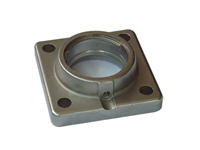
The introduction of Changzhou mechanical processing manufacturers first involves analyzing the workpiece according to the part drawings, preliminarily formulating the design plan of the inspection tool, determining the reference plane and concave convex situation of the inspection tool, detecting the cross-section, positioning surface, etc., and briefly drawing its two-dimensional schematic diagram. In the design of inspection tools, the specific design modeling of the inspection tool is crucial, as it directly affects whether the inspection tool can accurately detect the quality of the workpiece. Due to the characteristic of body panels being mainly free form surfaces, "physical reverse engineering" is currently a common modeling method. To achieve the detection of free surface of workpieces by inspection tools, it is generally necessary to maintain a constant gap of 3 or 5mm between the specific surface and the inner surface of the workpiece. CNC machining machines can achieve high accuracy requirements according to the designed surface modulus. In actual inspection, the deviation of the workpiece surface can be measured by reciprocating movement of the inspection tool surface in conjunction with a dedicated measuring tool. There are two main methods for detecting the outer contour of a workpiece. When designing the corresponding inspection tool:
① extend the specific surface outward by about 20mm along the tangential direction of the outer contour of the workpiece;
② Extend downwards about 20mm along the normal direction of the outer contour of the workpiece. Next, extend the surface along the tangent or normal direction of its contour by 20mm to obtain the specific detection surface, and then stretch it towards the reference plane at a certain interval to obtain the specific detection model. Due to the complexity of vehicle body coverings, a combination of the two methods mentioned above is often required for specific surface inspection. However, for some special profiles, this is still difficult to achieve.
The detection of key surfaces of workpieces is generally achieved through section templates. The section templates of inspection tools are divided into two types: rotary and insertion. When the span of the section template exceeds 300mm, to ensure the detection accuracy in the vertical direction, it is usually designed as an insertion type. The specific surface inspection is carried out on the inner surface of the workpiece, while the cross-sectional template spans across the outer surface of the workpiece to detect the outer surface of key cross-sections. Generally, the working surface is 2-3mm apart from the outer surface of the workpiece, and its modeling method is similar to that of the inspection tool surface. The material of the cross-section template is generally steel or aluminum, and the working surface can be made of aluminum or resin. The cross-section template of complex surfaces may interfere during rotation or insertion, and it can be segmented in practical design

Stretch a certain interval along the reference plane direction on the specific upper surface of the inspection, so that its minimum point is greater than 150mm in thickness, to ensure that the inspection has sufficient strength. At the same time, try to make the inspection specific bottom surface, that is, the upper surface (base surface) of the bottom plate assembly, in the integer position of the vehicle coordinate system. The specific bottom plate assembly is generally composed of a base plate, channel steel (if necessary, processed with steel in the middle), positioning blocks, and universal wheels. After the base plate is fixed by the specific inspection, other components can choose standard models according to the actual situation. Many important holes and flanges in the body stamping parts need to be separately inspected. In the design of inspection tools, a protrusion with a thickness of about 1mm is usually added to the surface of the inspection object. The center of the protrusion is on the same axis as the center of the workpiece hole, with a diameter 5mm larger than the aperture. Double marking is used to detect on the protrusion. When the accuracy requirements of the measured hole are relatively high, the positioning hole method is used to detect with plug gauges and bushings.